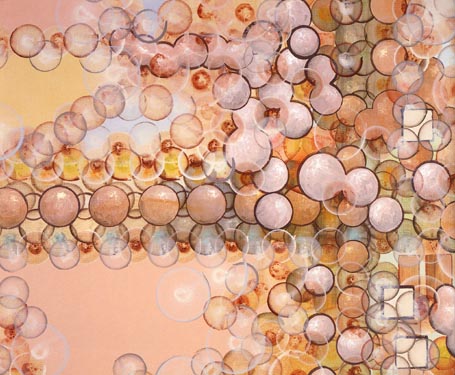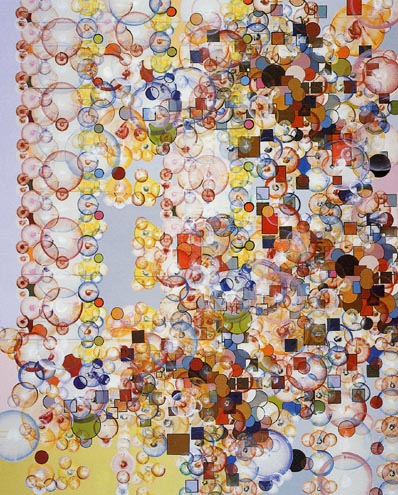Michael Rodriguez
by Tom Moody

Catalog essay for exhibition at Miami-Dade Community College
June 23 - July 24, 2000Imagine that a startup company in the "nano-chip" field, making circuit boards so tiny they can only be seen with an electron microscope, forms a joint venture with a major pharmaceutical manufacturer. The intended synergy, or pooling of resources of the two companies is a product that is part computer, part mind-altering drug, reconfiguring a patient's neural pathways at the molecular level. For its first presentation to investors, the venture commissions a series of visual aids depicting the microscopic circuitry in some detail; in an unusual move, it forgoes the usual Photoshop-graphics-on-foamboard and hires a painter-on-canvas to make the images. The venture's hope is to defuse investor fears about the scary, "cyborg" aspect of the project by giving charts, diagrams, and other design motifs a warm, tactile quality.
You're in the conference room now, surrounded by colorful networks of atoms, and as the R & D guy drones on, occasionally flicking a molecule with a laser pointer, you study the five-foot-high paintings. They're inviting and human, as requested, with a fantastically rich array of colors, but the more you look, the more you realize how many liberties the painter took with his assignment. Like snow crystals, none of the spherical "atoms" are exactly alike: some are transparent, some opaque; some are smooth and some inflected with subtle brushstrokes. Flat spaces between atoms oscillate between foreground and background. Small imperfections such as drips and slips of the hand reveal a process of revision and struggle. Without departing from the quest for scientific truth, the artist has pursued his own aesthetic truth.
Of course there is no corporate merger; no high-tech dog-and-pony show. Rather than paintings springing from a science fiction scenario, it is the scenario that springs from the paintings, specifically this group of mesmerizing, acrylic-on-canvas abstractions by Michael Rodriguez. Cumulative records of intuitively "right" aesthetic choices, the paintings are also plausible fictions that speak to our imminently posthuman time, when advancements in the biological sciences such as the decoding of the human genome are rapidly accelerating, nanotech is departing the laboratory for the marketplace, and "designer molecules" are reshaping our food, clothing, shelter, even bodies (all of which is accompanied, coincidentally or not, by an unprecedented blitz of molecular imagery in techno CD covers, screen savers, even deodorant ads.) 1
Yet while "molecules" have long been a key motif in Rodriguez's paintings, one should mention that they aren't real, in the sense of being appropriated from last month's copy of Scientific American. Instead they are an aggregation of signature marks, like Jackson Pollock's drips or Larry Poons' dots, which imply a larger, predetermined structure. In Rodriguez's case the "mark" is a translucent sphere or bubble, overlapping and abutting other bubbles in elegant, quasi-architectural chains. The artist makes no secret that each orb, like the gestural brushstroke of the Abstract Expressionists, is created with a quick motion of his hand: twirling a foam rubber brush tipped with acrylic paint against the canvas, he causes a darker area at the periphery of the circle to blend gradually into a lighter, apparently convex center. Small flecks of paint--imperfections in the blending--suggest particles floating within the sphere.
On the conceptual level, this illusionistic device (not so easy to figure out until you're told how it's done) comically reinvents the supposedly personal Ab Ex gesture as a robotic, assembly-line procedure. Yet compared to the flawless, computer-generated atoms that surround us in the mass media, the bubbles feel very eccentric and "hands on." Numbering in the hundreds and overlaid in rhythmic, organized clusters, these little spinning motors of visual seduction keep the eye moving--up, down, left, right--along imaginary conveyor belts within the shallow space of the painting, while the interstitial or "negative" spaces between the bubbles, meticulously filled in by hand, provide a constantly shifting color mosaic.
In Rodriguez's paintings from a few years ago, the spheres were mainly translucent white, with color confined to the negative spaces. The work also had an overtly textural dimension: the negative shapes were "flocked," like raised letters on a fuzzy greeting card, giving the paintings a quirky, craft store ambience. Gradually the relief elements were phased out and the hues became more complex and "allover," so that now, in the newest work, rhythmic color sequences pervade the spheres as well as the negative spaces. New pictorial elements have also appeared: hand-rendered, opaque orbs, and complicated arrays of circles and rectangles (drawn with templates), weaving over, under, and through the translucent sphere-clusters. In addition to their scientific connotations, the paintings suggest notation for some complex 21st Century music, a colorized, drum-and-bass equivalent of avant garde composer Karlheinz Stockhausen's highly visual scores.
In talking about his work, Rodriguez mentions his admiration for Ad Reinhardt, Robert Smithson, and Andy Warhol, three artists whose influence may not be immediately apparent in his painting, and whose styles would seem to have very little to do with each other. Reinhardt, that most minimal of abstractionists, disdained depth and modeling in his pursuit of progressively austere, black-on-black rectangles. Smithson abandoned painting early in his career for an art based on research and site investigation, eventually pioneering "earthworks" such as the famous Spiral Jetty in Utah's Great Salt Lake. Warhol, trained as an illustrator, created a permanent feedback loop between art and popular culture with artwork based on commercial packaging and mass media iconography.
Yet while the styles of these artists may not be apparent in Rodriguez's work, their respective agendas (art-for-art's-sake, art-for-science's-sake, and art-for-commerce's-sake) all come together in his paintings. Like Warhol, Rodriguez is drawn to artificial-looking color schemes, and one sees in his molecule paintings "yuppie" hues reminiscent of Brooks Brothers shirts or the soothing ergonomic palettes of private kindergarten walls. Like Smithson, his work takes inspiration from obscure (scientific) vocabularies originating outside the hermetic space of the gallery. Like Reinhardt, he is fascinated by the mechanisms transmitting sense data to the optical cortex, specifically how color variations reveal themselves slowly to the eye. Reconciling such diverse programs in one body of work is itself quite an achievement--whether or not it can be used to sell biotech to Luddites remains to be seen.
NOTES
1. See, e. g., Nicholas Wade, "Assembling of the Genome Is At Hand," New York Times, April 7, 2000, and Bill Joy, "Why the Future Doesn't Need Us," Wired, April 2000.
Above: Michael Rodriguez, Untitled, 1999, acrylic on canvas, 68 x 52 inches (detail); below: Untitled, 1999, acrylic on canvas, 65 x 50 inches
